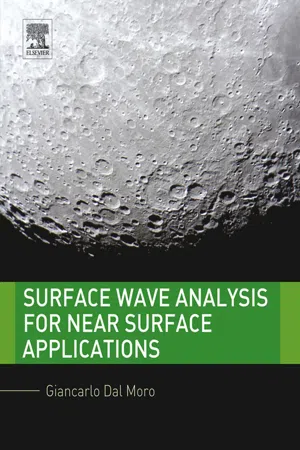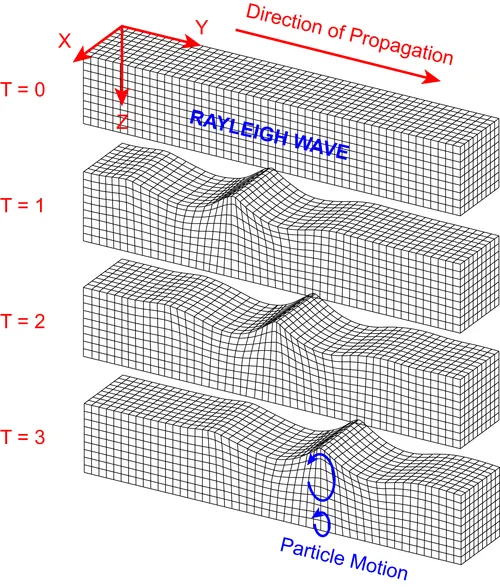
- 252 pages
- English
- ePUB (mobile friendly)
- Available on iOS & Android
eBook - ePub
Surface Wave Analysis for Near Surface Applications
About this book
Seismic Wave Analysis for Near Surface Applications presents the foundational tools necessary to properly analyze surface waves acquired according to both active and passive techniques. Applications range from seismic hazard studies, geotechnical surveys and the exploration of extra-terrestrial bodies.
Surface waves have become critical to near-surface geophysics both for geotechnical goals and seismic-hazard studies. Included in this book are the related theories, approaches and applications which the lead editor has assembled from a range of authored contributions carefully selected from the latest developments in research.
A unique blend of theory and practice, the book's concepts are based on exhaustive field research conducted over the past decade from the world's leading seismologists and geophysicists.
- Edited by a geophysicist with nearly 20 years of experience in research, consulting, and geoscience software development
- Nearly 100 figures, photographs, and examples aid in the understanding of fundamental concepts and techniques
- Presents the latest research in seismic wave characteristics and analysis, the fundamentals of signal processing, wave data acquisition and inversion, and the latest developments in horizontal-to-vertical spectral ratio (HVSR)
- Each chapter features a real-world case study—13 in all—to bring the book's key principles to life
Frequently asked questions
Yes, you can cancel anytime from the Subscription tab in your account settings on the Perlego website. Your subscription will stay active until the end of your current billing period. Learn how to cancel your subscription.
No, books cannot be downloaded as external files, such as PDFs, for use outside of Perlego. However, you can download books within the Perlego app for offline reading on mobile or tablet. Learn more here.
Perlego offers two plans: Essential and Complete
- Essential is ideal for learners and professionals who enjoy exploring a wide range of subjects. Access the Essential Library with 800,000+ trusted titles and best-sellers across business, personal growth, and the humanities. Includes unlimited reading time and Standard Read Aloud voice.
- Complete: Perfect for advanced learners and researchers needing full, unrestricted access. Unlock 1.4M+ books across hundreds of subjects, including academic and specialized titles. The Complete Plan also includes advanced features like Premium Read Aloud and Research Assistant.
We are an online textbook subscription service, where you can get access to an entire online library for less than the price of a single book per month. With over 1 million books across 1000+ topics, we’ve got you covered! Learn more here.
Look out for the read-aloud symbol on your next book to see if you can listen to it. The read-aloud tool reads text aloud for you, highlighting the text as it is being read. You can pause it, speed it up and slow it down. Learn more here.
Yes! You can use the Perlego app on both iOS or Android devices to read anytime, anywhere — even offline. Perfect for commutes or when you’re on the go.
Please note we cannot support devices running on iOS 13 and Android 7 or earlier. Learn more about using the app.
Please note we cannot support devices running on iOS 13 and Android 7 or earlier. Learn more about using the app.
Yes, you can access Surface Wave Analysis for Near Surface Applications by Giancarlo Dal Moro in PDF and/or ePUB format, as well as other popular books in Physical Sciences & Geophysics. We have over one million books available in our catalogue for you to explore.
Information
Chapter 1
Introducing Surface Waves
Abstract
In this first chapter, we introduce basic aspects regarding surface wave generation and propagation. The comprehension of these facts will be crucial to then carry out the analysis of their dispersion (and attenuation) and, consequently, define a good subsurface model.
For properly identifying each “object” relevant for our analyses, the use of a proper terminology is crucial. The central concepts of dispersion curve and velocity spectrum will be defined giving the necessary emphasis to their different meaning in terms of data analysis.
Keywords
Anisotropy; Attenuation; Attenuation curve; Dispersion; Dispersion curve; Effective dispersion curve; Love waves; Modal dispersion curve; Nonuniqueness; Rayleigh waves; Scholte waves; Surface waves; Velocity spectrumWe begin where we are.
Robert Fripp
1.1. A Brief Introduction
As very well known from basic seismology courses, fundamentally there are two kinds of seismic waves: those propagating inside a medium (body waves) and those traveling along the very shallow part of it (surface waves (SWs)). Compressional waves (commonly indicated as P waves) and shear waves (S waves) are body waves while Rayleigh, Scholte, Stoneley, and Love waves are different kinds of SWs.
In the last decades, a number of papers dealing with SWs have been published but it must be recalled that their theoretical description and first applications date back to almost a century ago.
SWs have been in fact used for a number of applications since the 1920s: Nondestructive testing (even for medical applications), geotechnical studies, and crustal seismology (e.g., Gutenberg, 1924; Evison et al., 1959; Viktorov., 1967; McMechan and Yedlin, 1981; Kovach, 1978; Roesset, 1998; Stokoe et al., 1988; Stokoe and Santamarina, 2000; Jørgensen and Kundu, 2002; O'Neill et al., 2003; 2004; Gaherty, 2004; Pedersen et al., 2006; Luo et al., 2007; O'Connell and Turner, 2011; Prodehl et al., 2013).
Recently the interest toward their application has increased both for the increasing demand for efficient methodologies to apply in geotechnical studies and because the recent regulations addressing the assessment of the seismic hazard (see for instance the Eurocode8) are giving the necessary emphasis to the determination of the shear-wave velocity vertical profile.
Because of their practical importance and wide use in a number of near-surface applications, we will focus our interest on Rayleigh and Love waves in the following.
1.2. Lord Rayleigh and Prof. Love
There are two kinds of SWs actually relevant while analyzing seismic waves propagating on land: Rayleigh and Love waves. The first ones were described mathematically by Lord Rayleigh in 1885 (Rayleigh, 1885), while it was Prof. Love who, in 1911, described the kind of waves that were then named after him (Love, 1911).
The fundamental characteristics of Rayleigh waves are represented in the sketch reported in Figure 1.1. The wave (traveling in the direction of propagation) induces an elliptical (retrograde) motion (see the blue ellipse drawn at time T = 3) whose amplitude exponentially decreases with depth. Such elliptical motion is the result of the superposition of the vertical and horizontal (more specifically radial) components (Figure 1.2).

Love waves are somehow simpler than Rayleigh waves because (Figures 1.3 and 1.4) they move only on the horizontal plane, transversally with respect to the direction of propagation. Incidentally, this simplicity also mirrors in both the computational load necessary to solve their constitutive equations (and describe their propagation), both in their phenomenology which, how we will broadly see in the next chapters and in several presented case studies, will result extremely useful (even necessary) to solve puzzling interpretative issues related to complex Rayleigh-wave velocity spectra.
Let us now summarize further basic facts:
• While considering a surface normal load, the energy converted into Rayleigh waves is by far predominant (67%) with respect to the energy that goes into P (7%) and S (26%) waves (Miller and Pursey, 1955);
• Rayleigh and Love waves are called SWs because their amplitude exponentially decreases with depth, thus the motion induced by their passage is limited to a shallow portion (whose depth depends on the considered wavelength λ—see later on);

• Just because their energy is confined to a shallow layer, while expanding from the source (geometrical spreading), their amplitude decreases fundamentally according to the square root of the distance from the source, while body waves (whose propagation involves a semisphere and not just a circle) lose their energy (thus amplitude) according to the distance (because of this, the amplitude of the body waves decreases much more with respect to SWs and consequently SWs tend to dominate the data);
• Compared to body waves, their amplitude is remarkably larger and, for this reason, in the low-frequency range they dominate the data and are therefore often referred to as ground roll (Figure 1.5 r...
Table of contents
- Cover image
- Title page
- Table of Contents
- Quote
- Copyright
- Preface
- Chapter 1. Introducing Surface Waves
- Chapter 2. Data Acquisition
- Chapter 3. Understanding Surface-Wave Phenomenology
- Chapter 4. Horizontal-to-Vertical Spectral Ratio
- Chapter 5. Inversion and Joint Inversion
- Chapter 6. Full Velocity Spectrum Inversion and Other Unconventional Approaches
- Chapter 7. Some Final Notes
- Appendix—A Collection of Commented Case Studies
- Case Study 1. A Simple ZVF Analysis for Geotechnical Purposes
- Case Study 2. A Simple (but Educational) Case Study
- Case Study 3. Inverse Dispersion by the Book
- Case Study 4. When the Joint Analysis of Love and Rayleigh Waves Is Necessary
- Case Study 5. Joint Analysis of Rayleigh-Wave Dispersion and P-Wave Refraction
- Case Study 6. A Comprehensive Survey in the Swiss Alps
- Case Study 7. Joint Analysis of Rayleigh and Love Waves via Full Velocity Spectrum Analysis
- Case Study 8. A Civil Engineering Job
- Case Study 9. A Landslide Area
- Case Study 10. Back to the Swiss Alps
- Case Study 11. Modes and Components (A Very Tricky Site)
- Case Study 12. Analyzing Phase and Group Velocities Jointly with Horizontal-to-Vertical Spectral Ratio
- Case Study 13. Some Focus on Horizontal-to-Vertical Spectral Ratio Computation
- Case Study 14. Surface Waves on the Moon
- References
- Index